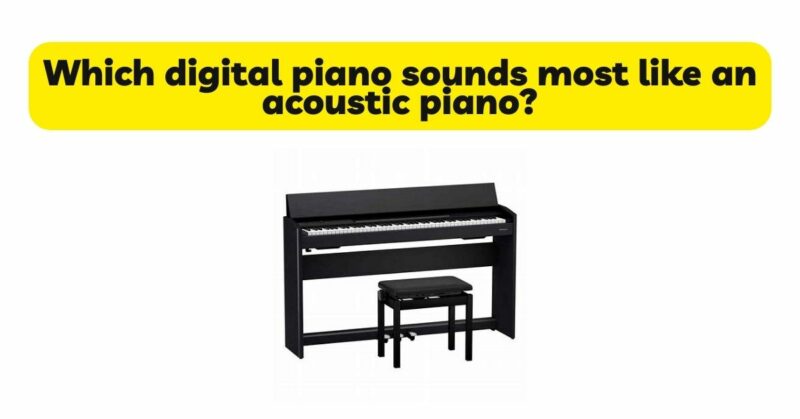For pianists seeking the sound of an acoustic piano in a digital instrument, advancements in technology have made it possible to come remarkably close to replicating the tonal characteristics and nuances of acoustic pianos. While no digital piano can fully capture the organic complexities of an acoustic piano, many models employ sophisticated sound sampling and modeling techniques to deliver highly realistic piano sounds. In this article, we delve into the key factors that contribute to a digital piano sounding like an acoustic piano, including sound sampling, sound modeling, resonance simulation, dynamic range, and sound processing capabilities. By examining these elements, we aim to provide insights into digital pianos that strive to replicate the rich, resonant, and expressive sound of acoustic pianos, helping pianists make informed decisions based on their musical preferences and requirements.
- Sound Sampling: Sound sampling is a critical technique employed by digital pianos to replicate the sound of an acoustic piano. High-quality digital pianos incorporate extensive sample libraries recorded from real acoustic pianos. These samples capture the distinct characteristics of each individual piano note, including the attack, sustain, and decay. By meticulously mapping these samples to the corresponding keys, digital pianos recreate the timbre, dynamics, and resonance of an acoustic piano, offering a highly realistic and authentic piano sound.
- Sound Modeling: Sound modeling is another approach utilized by digital pianos to emulate the sound of acoustic pianos. This technique involves creating algorithms that simulate the physical interactions and behavior of acoustic pianos. By modeling the complex mechanics of strings, hammers, and resonant bodies, digital pianos can reproduce the tonal nuances and subtleties unique to acoustic pianos. Sound modeling technology allows for greater customization and control over the piano sound, offering pianists the ability to adjust parameters and create personalized tonal profiles that closely resemble the sound of their preferred acoustic pianos.
- Resonance Simulation: Resonance simulation is a key factor in reproducing the authentic sound of an acoustic piano. Acoustic pianos possess a rich resonance that occurs when the strings and soundboard interact. Digital pianos employ advanced algorithms to simulate sympathetic string resonance, which recreates the complex interplay of vibrations between strings when certain keys are pressed. This simulation enhances the depth, warmth, and naturalness of the piano sound, closely replicating the resonant qualities of an acoustic piano.
- Dynamic Range: The dynamic range is an important aspect of an acoustic piano’s sound and is crucial to recreating the piano-like sound on a digital instrument. Acoustic pianos offer a wide range of dynamic expression, from delicate pianissimos to powerful fortissimos. Digital pianos aim to replicate this dynamic range through velocity-sensitive keys and sophisticated sound processing techniques. By capturing and reproducing the nuances of key velocity and touch, digital pianos can provide a similar level of dynamic expressiveness, enabling pianists to achieve a highly expressive and nuanced performance.
- Sound Processing: Digital pianos employ sound processing techniques to refine and enhance the piano sound. These techniques simulate the natural characteristics of acoustic pianos, such as damper pedal resonance, key-off samples, and sympathetic resonance. Damper pedal resonance, for example, recreates the interaction between the dampers and strings when the sustain pedal is used, resulting in a more immersive and resonant sound. Key-off samples replicate the subtle sound produced when a pianist releases a key, adding to the realism and authenticity of the piano sound. By incorporating these sound processing features, digital pianos can achieve a more lifelike and convincing acoustic piano sound.
- High-Quality Speaker Systems: The quality and design of the speaker system in a digital piano play a crucial role in reproducing the sound of an acoustic piano. High-quality digital pianos incorporate dedicated speaker systems that are carefully designed to accurately project the nuances and subtleties of the piano sound. These speaker systems are positioned strategically to create a spatial representation of the sound, providing a more immersive and realistic playing experience. The inclusion of quality speakers ensures that the nuances and complexities of the piano sound are faithfully reproduced, enhancing the overall piano-like sound quality.
Conclusion: While digital pianos cannot fully replicate the organic complexities and tonal richness of acoustic pianos, significant advancements in technology have allowed them to come remarkably close in emulating the sound of their acoustic counterparts. By employing sound sampling, sound modeling, resonance simulation, dynamic range, sound processing, and high-quality speaker systems, digital pianos can deliver highly realistic and expressive piano sounds. The choice between a digital piano and an acoustic piano ultimately depends on individual preferences, musical requirements, and the desired balance between authenticity, convenience, and versatility. By selecting a digital piano that excels in sound replication and captures the essence of an acoustic piano, pianists can experience the joys of playing a highly expressive and lifelike instrument, opening up a world of musical possibilities and creative exploration.

